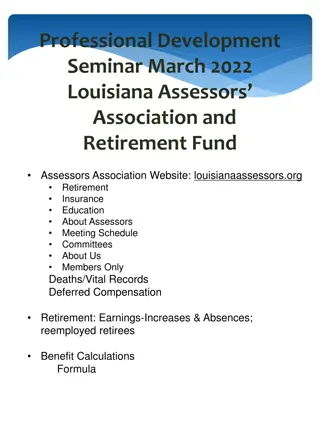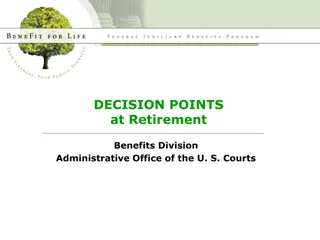Understanding Retirement Benefits and Employment Laws in Canada
Explore the intricacies of retirement benefits and employment laws in Canada, delving into pension plans, non-pension benefits, unionized vs. non-unionized employment, risks associated with termination, and statutory protections for workers, providing valuable insights for both employees and employers.
Download Presentation

Please find below an Image/Link to download the presentation.
The content on the website is provided AS IS for your information and personal use only. It may not be sold, licensed, or shared on other websites without obtaining consent from the author. Download presentation by click this link. If you encounter any issues during the download, it is possible that the publisher has removed the file from their server.
E N D
Presentation Transcript
Industrialization Farm to factory End of family enterprise Counter-unionization Human face Benefit tied to keeping your job. Rationalization Pyramid organization Retain skilled workers Exit for less productive
NON-PENSION BENEFITS PENSIONS Defined contribution Promise to pay fixed amount into account while working Pension based on amount in account on retirement, employee takes risk may be inadequate Defined benefit Promise to pay amount for life on retirement If funding inadequate employer to make up difference Life insurance Age factor in premiums Extended health Utilization increase with age Dental Age not as big a factor
NON-UNIONIZED EMPLOYMENT UNIONIZED EMPLOYMENT Employment Law Employer may terminate without cause Must provide reasonable notice of termination Termination without notice = wrongful dismissal Damages = compensation for lack of notice Employer unilateral changes only constrained by willingness to terminate, if employee objects Collective bargaining law Employer may not terminate without just cause Unjust dismissal may = reinstatement + compensation for lost wages Employer obliged to negotiate changes in terms of employment with union
NON-UNIONIZED UNIONIZED Risks Termination before vesting Vesting within notice period Unilateral change active Defiance or termination Unilateral change retired Ill-defined rights Interpretation as contingent or subject to amendment If vested - employer solvency. Risks Just cause protection Can satisfy vesting conditions Changes must be bargained Active -retirement benefits dependent on bargaining power Retirees can union bargain to reduce benefits for retirees? Access to remedy if union won t take grievance
Same statutory protection - union/non-union No retroactive benefit reductions Prospective reduction/termination permitted Only security against this same as for non-pension benefits Short period vesting Claim not extinguished by termination
Non-pension Pension Non-pension Union Both union and non- union Non-union
Constitutional Factors Insolvency: federal; Employment: provincial Federal paramountcy conflict or undermining purpose Factors affecting the odds Priority of claims in a liquidation Union or non-union Type of benefit Presence of separate fund
No possibility of successor rights claim Sale of assets by trustee and distribution Governed by scheme of priorities in BIA Some protection for active employee wages up to $2,000 secured charge Retiree benefits unsecured charge share what s left Liquidation same whether union or non-union Zero security Exception funds set aside for future costs Must be in third party custody trust, insurance, etc.
Plan termination No further benefits Accrued benefits secured by pension fund Funded by employer/employee contributions as benefits accrued Held by third party employer s creditors denied access Security dependent on adequate funding If not adequate pension law requires employer pay difference Insolvency law - payments to pension fund unsecured except the arrears for normal cost of benefits
Pension law provisions intended to increase priority in insolvency rejected by courts Deemed trust, lien and charge. Courts concerned about provincial property and civil rights legislation altering federal priorities in insolvency Insistence that only real trusts be recognized Interpretation of secured charge to restrict one created in pension legislation
Goal continue the business in some form Generates more value for creditors than piecemeal liquidation Employer remains in ostensible control Court - stay of all proceedings against employer Cease making payments for pension shortfall or non- pension benefits Rationale pre-insolvency debts can t pay some before others Federal authorization for court to make order - paramountcy provincial legislation of no force and effect if impair federal objectives
Can require immediate payment for services Can t be required to work for less than collective agreement rates Continued payment for their pension costs as benefits accrued [but not for any pre-insolvency shortfall] Not applicable for payment falling due after insolvency for pre-insolvency service
NON-UNION UNION Insolvency statutes Authorize disclaimer of contracts Enhance prospects for restructuring No significant financial hardship to other party Other party gets provable claim dealt with in final plan Not applicable to pension benefits Vesting & separate funding Insolvency statutes Exempt collective agreement from disclaimer regime Union must agree to any amendments Pension benefits protected by vesting & separate funding
Retirees have little to trade in restructuring Contrast active employees If retiree benefits in collective agreement advantage Could also be rolled into separate trust Employer obligations fixed to defined contributions Pension benefits compromise Lengthen time to pay shortfall [from 5 10 years] Now being offered to employers outside of insolvency Risks to security increased with length of extension
Non-union Union Pensions Non-pension Disclaimer Non-pension Compromise of retiree benefits Funding Extensions of time to pay
Pension benefits Recognize that there are known unknowns Clearly assign the risks of miscalculation Price [contributions] affects degree of risk Non-pension benefits Adopt the pension fund pre-funding/vesting model Consistent with accounting treatment The known unknowns are different Assign the risks based on price [contributions]
Arbitrary basis Union v. non-union Pension v. non-pension Disconnected from the essence of the promise Work today benefits tomorrow Should be recognized as deferred wages Similar treatment should be mandated. Better to pay for benefits as they are earned Unfair to lay the burden on next generation























